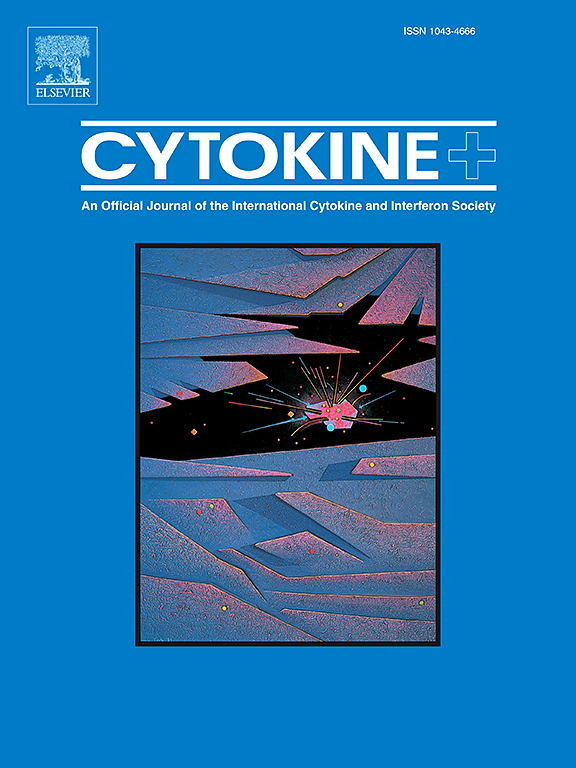Based on the IL-33/ST2-MyD88 signaling pathway to explore the mechanism of aerobic exercise in antagonizing the inflammatory response in depressive mice
IF 3.7
3区 医学
Q2 BIOCHEMISTRY & MOLECULAR BIOLOGY
引用次数: 0
Abstract
Purpose
This study examined how aerobic exercise affect the IL-33/ST2-MyD88 signaling pathway in mice with chronic unpredictable mild stress (CUMS) induced depression
Method
Thirty-six C57BL/6 mice were randomly assigned t three groups: a control group (CG), a model group (MG), and an exercise group (ME). We created a depression model using chronic unpredictable mild stress, after which the ME group underwent 8 weeks of aerobic training. After exercise intervention, neurobehavioral assessment was performed. ELISA was used to detect the levels of IL-33, IL-1β and IL-10 in the serum of mice. Toluidine blue Nissl staining was used to observe the structure of hippocampal neurons. Total RNA was extracted from blood samples using magnetic beads and from hippocampal tissue or neurons using Trizol. The levels of IL-33, ST2, MyD88, IL-1β, IL-10 and NF-κB mRNA in mice were detected by RT-PCR
Result
The number of lattice crossings and modification times were significantly reduced in MG group, the exercise time was significantly shortened, and the sugar and water preference index was significantly reduced, while the immobility time in forced swimming and tail suspension tests were significantly prolonged. The results indicated that CUMS successfully induced anhedonia and depression-like behaviors in the mice. In the ME group, there was a significant increase in the number of crossing lattices, modification times, exercise duration, and sugar and water preference index, while the immobility time in the forced swimming and tail suspension tests significantly decreased. Compared with the CG group, serum levels of inflammatory factors IL-33, IL-1β, and NF-κB significantly increased in the MG group, while these levels significantly decreased in the ME group. It decreased and IL-10 showed a very significant increase. Nissl staining results indicated that hippocampal nerve cells in MG group were sparsely arranged, with widened gaps, severe nucleus contraction, and shallow staining. The ME group had reduced neuronal vacuoles and improved nuclear shrinkage. Immunohistochemical results revealed that in MG group, the expression of pro-inflammatory factors IL-1β and MyD88 increased. In Contrast, the ME group exhibited a decrease in IL-1β and MyD88, alongside a significant increase in the anti-inflammatory factor IL-10. In the RT-PCR test results, the blood inflammation signal pathway IL-33/ST2 and its downstream factors MyD88, NF-κB, and IL-1β mRNA were significantly up-regulated, and the inhibitory factor IL-10 mRNA was up-regulated in MG group. Gene expression trends for IL-33 mRNA, ST2 mRNA, IL-1β mRNA, MyD88 mRNA and NF-κB mRNA in hippocampus tissue were similar to those in blood, all showing significant up-regulation. In contrast, IL-10 mRNA did not exhibit significant up-regulation. While IL-33/ST2 expression did not significantly decrease, other pro-inflammatory factors showed significant down-regulation, and anti-inflammatory factors demonstrated significant up-regulated. Similarly, IL-33 mRNA, ST2 mRNA and MyD88 mRNA expressions in the hippocampus of ME mice mirrored the changes observed in blood when compared to MG mice. NF-κB mRNA was significantly down-regulated, while IL-1β mRNA showed no significant change, and IL-10 mRNA was up-regulated, albeit not significantly.
Conclusion
Aerobic exercise may counteract the CUMS depression model in mice by regulating the IL-33/ST2-MyD88 signaling pathway. The strong correlation of inflammatory cytokines between blood and hippocampus indicated that assessing inflammatory damage in the hippocampus could be done through blood tests of the signaling pathway and related cytokine levels.

基于IL-33/ST2-MyD88信号通路,探讨有氧运动对抗抑郁小鼠炎症反应的机制
目的研究有氧运动对慢性不可预测轻度应激(CUMS)所致抑郁症小鼠IL-33/ST2-MyD88信号通路的影响。方法将36只C57BL/6小鼠随机分为对照组(CG)、模型组(MG)和运动组(ME)。我们使用慢性不可预测的轻度压力创建了一个抑郁模型,之后,ME组进行了8周的有氧训练。运动干预后进行神经行为评估。采用ELISA法检测小鼠血清中IL-33、IL-1β和IL-10的水平。采用甲苯胺蓝尼氏染色观察海马神经元结构。用磁珠从血液样本中提取总RNA,用Trizol从海马组织或神经元中提取总RNA。rt - pcr检测小鼠体内IL-33、ST2、MyD88、IL-1β、IL-10和NF-κB mRNA水平。结果MG组小鼠格交次数和修饰次数显著减少,运动时间显著缩短,糖偏好指数和水偏好指数显著降低,强迫游泳和悬尾静止时间显著延长。结果表明,CUMS成功诱导小鼠快感缺失和抑郁样行为。在ME组中,穿越格数、修饰次数、运动时间、糖和水偏好指数显著增加,而在强迫游泳和悬尾试验中,静止时间显著减少。与CG组比较,MG组大鼠血清炎症因子IL-33、IL-1β、NF-κB水平显著升高,ME组大鼠血清炎症因子IL-33、IL-1β、NF-κB水平显著降低。白细胞介素-10明显升高。尼氏染色结果显示,MG组海马神经细胞排列稀疏,间隙加宽,核收缩严重,染色浅。ME组神经元空泡减少,核收缩改善。免疫组化结果显示,MG组促炎因子IL-1β、MyD88表达升高。相比之下,ME组表现出IL-1β和MyD88的下降,同时抗炎因子IL-10的显著增加。RT-PCR检测结果显示,MG组血液炎症信号通路IL-33/ST2及其下游因子MyD88、NF-κB、IL-1β mRNA显著上调,抑制因子IL-10 mRNA上调。海马组织中IL-33 mRNA、ST2 mRNA、IL-1β mRNA、MyD88 mRNA和NF-κB mRNA的表达趋势与血中相似,均显著上调。相比之下,IL-10 mRNA未表现出明显的上调。IL-33/ST2表达不明显降低,其他促炎因子显著下调,抗炎因子显著上调。同样,与MG小鼠相比,ME小鼠海马中IL-33 mRNA、ST2 mRNA和MyD88 mRNA的表达反映了血液中观察到的变化。NF-κB mRNA显著下调,IL-1β mRNA无显著变化,IL-10 mRNA上调,但均不显著。结论有氧运动可能通过调节IL-33/ST2-MyD88信号通路来对抗小鼠CUMS抑郁模型。血液和海马之间炎症因子的强相关性表明,可以通过血液检测信号通路和相关细胞因子水平来评估海马的炎症损伤。
本文章由计算机程序翻译,如有差异,请以英文原文为准。
求助全文
约1分钟内获得全文
求助全文
来源期刊

Cytokine
医学-免疫学
CiteScore
7.60
自引率
2.60%
发文量
262
审稿时长
48 days
期刊介绍:
The journal Cytokine has an open access mirror journal Cytokine: X, sharing the same aims and scope, editorial team, submission system and rigorous peer review.
* Devoted exclusively to the study of the molecular biology, genetics, biochemistry, immunology, genome-wide association studies, pathobiology, diagnostic and clinical applications of all known interleukins, hematopoietic factors, growth factors, cytotoxins, interferons, new cytokines, and chemokines, Cytokine provides comprehensive coverage of cytokines and their mechanisms of actions, 12 times a year by publishing original high quality refereed scientific papers from prominent investigators in both the academic and industrial sectors.
We will publish 3 major types of manuscripts:
1) Original manuscripts describing research results.
2) Basic and clinical reviews describing cytokine actions and regulation.
3) Short commentaries/perspectives on recently published aspects of cytokines, pathogenesis and clinical results.
 求助内容:
求助内容: 应助结果提醒方式:
应助结果提醒方式:


